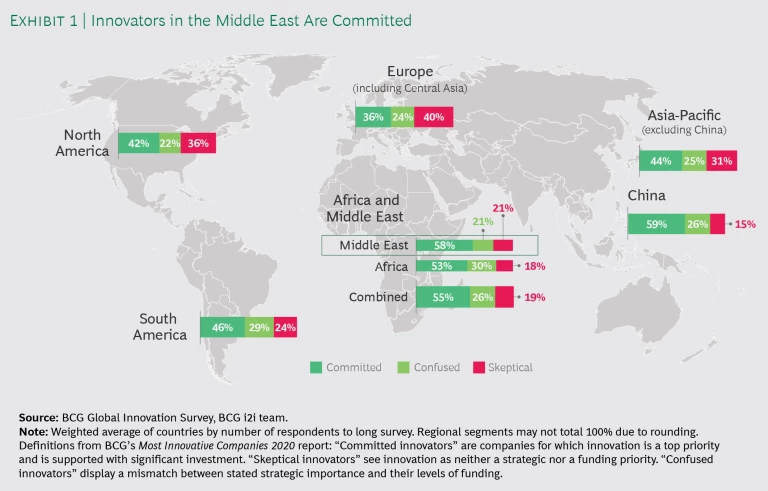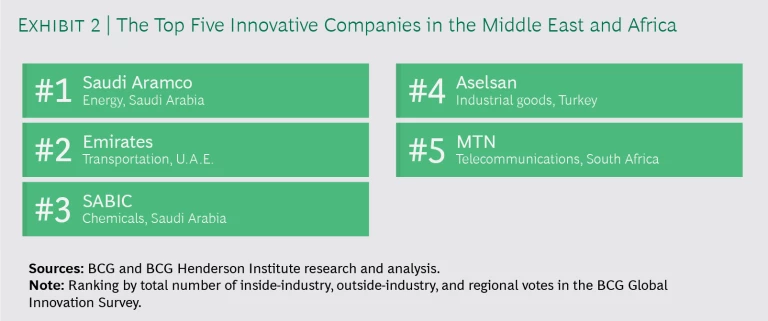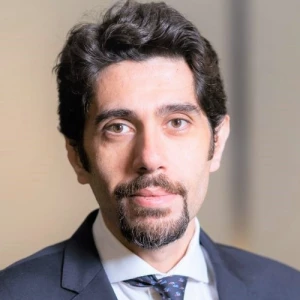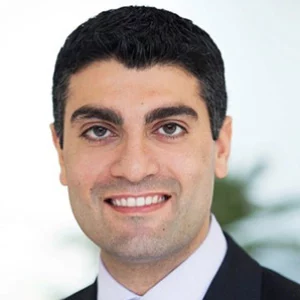BCG’s 2020 global innovation survey reveals that the Middle East has become an active innovation center, characterized by leading players large and small. As the economies of the region seek to diversify away from their historical dependence on oil and gas, and as the energy industry itself adapts to global market shifts, the importance of innovation will only increase.
In innovation, as in many other matters, commitment counts. Our 2020 Most Innovative Companies report shows that committed innovators—those companies that make innovation a top priority and invest decisively behind that ambition—outperform. Almost 60% of committed innovators worldwide report that they generate a rising proportion of their sales from products, services, or business models launched within the past three years, far exceeding their industry peers.
The Middle East is home to some of the most committed innovators in the world. As a region, the Middle East ranks second only to China in its level of
This article examines the current state of innovation in the region and offers some thoughts on how Middle Eastern companies can accelerate innovation’s impact.
Innovation Today
Middle East executives are on par with executives elsewhere when it comes to declaring innovation a priority. Our 2020 survey found that 63% regard innovation as a Top 3 priority, compared with a global mean of 66%. Some 57% of companies in the Middle East, compared with 60% globally, plan to invest more in innovation activities.
Middle Eastern executives believe they follow established global best practices. They score their own firms’ innovation maturity at 71%, which is nearly as high as that of Chinese respondents (72%) and 7 points higher than Germany, 10 points higher than the US, and 12 points higher than Japan and the UK. This is particularly important because serial innovators use “innovation systems” to generate new value propositions and solve them at scale (see below, in the section “How to Keep Moving Forward”). These companies still have room to improve when it comes to practicing agile teaming—that is, working in nonhierarchical, cross-functional structures and iterating in a hypothesis-led manner toward innovative solutions.
There are many examples of successful innovators throughout the region, starting with its largest company, Saudi Aramco, which is recognized by global innovation executives as the Middle East’s top innovator. (See Exhibit 2.)
Aramco is leading multiple innovative efforts to reimagine the internal combustion engine for tomorrow. One is mobile carbon capture, a technology spearheaded by Aramco scientists that can capture up to 25% of the CO2 emitted in a vehicle’s exhaust. The goal is to raise that capability to 50%. Captured CO2 is stored onboard the vehicle for later collection and use in a variety of industrial and commercial applications, including powering heavy-duty vehicles and freight transport. The technology has been successfully demonstrated in two prototypes, a pickup truck and a midsize passenger vehicle. Aramco is also working with automakers to develop an engine that is as efficient as an internal ignition (diesel) engine but runs on gasoline and therefore does not produce significant levels of soot and NOx emissions. Gasoline compression ignition engines have the potential to reduce fuel consumption and CO2 emissions by 25% compared with typical internal combustion engines.
Take another example: the airline Emirates, the region’s number two innovator in our survey, which has grown from operating two aircraft in 1985 to flying the world’s largest long-haul fleet. Emirates has long been recognized for pushing the boundaries on cabin design and in-flight comfort and service, as almost any international frequent flyer can attest. The company’s Aviation X Lab combines the airline’s capabilities with those of digital partners and equipment suppliers to improve the travel experience for customers, inside and outside of the aircraft. For example, its Hub Monitor application, built in-house, monitors in real time the turnaround performance of aircraft at the Dubai hub and helps identify and resolve potential delays.
Innovation Tomorrow
Going forward, innovators in the Middle East have significant resources that they can leverage. These include large national and industry transformation programs that encompass multiple sectors, such as UAE Vision 2021, Saudi Arabia Vision 2030, and Qatar’s National Vision 2030. Many companies are pursuing new technologies outside of traditional areas of strength, such as solar power. The Middle East is emerging as a melting pot for multinational corporations and leading global academic institutions, and Middle Eastern governments and private institutions have established global partnerships that serve the innovation agenda.
The region’s large population of young people facilitates adoption of new ways of working and advanced technologies, such as machine learning and artificial intelligence (AI). The impact of the latter on innovation is well documented, including in our own The Most Innovative Companies 2018 report . New BCG research on digital acceleration shows that Middle Eastern companies in several sectors are especially well positioned in this regard, with very high shares of bionic companies (those that effectively combine human and advanced technological capabilities) in such industries as technology (60%), financial services (53%), and consumer goods (64%).
The region’s large population of young people facilitates adoption of new ways of working and advanced technologies.
One of the primary ways that digital maturity drives performance is the ability to combine large data sets with AI, which accelerates innovation, product development, and testing, thereby reducing time to market and conferring first-mover advantage. For example, Nala, the company behind the world’s first Arabic AI health platform, enables more than 50,000 users to obtain precision medical diagnoses through its mobile app.
Another advantage is that Middle Eastern companies are good at marrying global innovations with local knowledge and experience to create new markets and substantial value—and then attracting global interest to the region. Careem, for example, is a ride-hailing app with a clear local value proposition: offer convenient transportation in Middle Eastern cities that lack extensive public transportation infrastructure or widespread car ownership. Established in 2012, Careem now operates in more than 100 cities in 14 countries and has created more than a million jobs in the region. The startup began as a web-based service for corporate car bookings, but it quickly evolved into a transportation network company that provides a customized offering suited to the needs of average people in a region that lives on services, deliveries, and convenience but seeks to limit outside exposure in the summer. Careem, which recently launched delivery and payment services, was acquired by global industry leader Uber in 2020.
Middle Eastern companies are good at marrying global innovations with local knowledge to create new markets and substantial value.
Middle Eastern innovators often find ways to leap-frog existing institutional or technological barriers (as well as traditional competitors) to develop new solutions. Souq.com, founded in 2005 in Dubai, UAE, has grown to be the largest e-commerce company in the Middle East, serving customers in seven countries with a combined population of more than 135 million people and employing more than 3,000. It was able to circumvent the regional delivery issue caused by the absence of postal codes by using a smart geo-location system. It has since turned its tech-enabled delivery service into a separate business (Q Express), which it offers to third parties.
Souq understood that its big opportunity lay less in bringing together individual buyers and sellers than in linking customers with retail merchants and made the switch early from a B2B business to a B2C-only business. It approached its payment system as a distinct entrepreneurial venture rather than just another in-house development project. Launched under the brand name PayFort in 2013, it has since become the leading online payment provider in the Middle East.
Souq was acquired by Amazon in 2017. Since the acquisition, Amazon has focused on integrating Souq’s local know-how and Amazon’s global expertise. Souq.com was rebranded to Amazon.ae in the UAE in 2019 and to Amazon.sa in Saudi Arabia in 2020.
How to Keep Moving Forward
The challenge for leaders in the Middle East, as elsewhere, will be to keep the innovation machine well lubricated and smoothly operating. Innovation systems are multifaceted. They involve people and teams from multiple functions. They can have lots of moving organizational parts: R&D, ecosystem partners, incubators, accelerators, and corporate venture funds. They are also dynamic. They need to be designed and regularly reworked to deliver the desired level of profitable organic growth—and the parts always need to act as a whole toward a common result.
Data from BCG’s global innovation benchmarking database shows that companies with better systems achieve an increase of 5 to 20 percentage points in their innovation output (the percentage of sales from products, services, or business models introduced in the past three years). An effective innovation journey starts with doing the careful work of establishing a common language on innovation, building a fact base for framing the challenge, and getting CEO buy-in. We find that a series of pointed questions, each focusing on one of the ten essential elements of a company’s innovation system, provides a good way to start. The questions for innovators in a post-COVID world reflect the typical gaps we see between leading innovators (benchmark companies) and those aiming to join their ranks. (These questions are explored in more detail in the article from our 2020 report that examines how serial innovators deliver success repeatedly over time.) The questions include the following:
- Do we have a shared innovation purpose?
- Is our innovation strategy grounded in the deep customer insight and foresight that can help us decide what to do—and not do—and enable us to adjust to shifting opportunities?
- Do we ensure that people and budgets are aligned with our shared innovation priorities—and promptly realigned when priorities shift?
- Do our metrics and incentives reward both predictable, incremental progress and successful step-change innovation?
- Do we have clear roles for all the disparate elements of our broader innovation ecosystem?
- Do we have true business builders, and do we allocate our very best talent to our most ambitious innovation challenges?
- What’s the last truly novel idea we developed that solved a “hair on fire” problem for customers?
- Do we have a clear view of our unfair advantage relative to our competition?
- Is our funnel of potentially valuable projects actually funnel-shaped or is it a cylinder?
- Do we manage our portfolio strategically—for example, to ensure balance between core and noncore elements or among new products, services, and business models?
Middle Eastern companies are already well along on their innovation journey. The challenge going forward will be to maintain their ambition, focus their strategy on areas of unique advantage, and create ecosystems in which aspiring local and global talent can come together with investors to shape novel business models. The public sector and ambitious large-scale innovators such as Saudi Aramco and Emirates have a role to play. Celebrated homegrown success stories like those of Souq and Careem will light the way.














